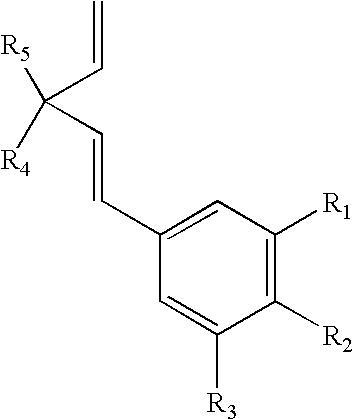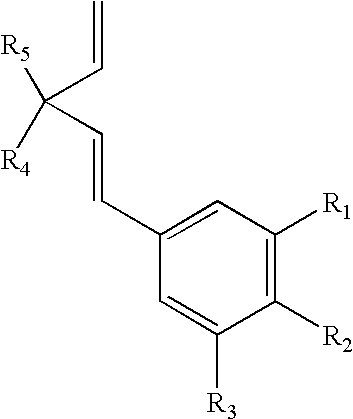Skin appearance through gene manipulation
a gene and gene technology, applied in the field of skin appearance through gene manipulation, can solve the problems of skin aging and environmental damage, increased pore size, extrinsic concerns, etc., and achieve the effects of reducing and/or reversing preventing or slowing down the adverse effects of skin aging, and improving skin appearan
- Summary
- Abstract
- Description
- Claims
- Application Information
AI Technical Summary
Benefits of technology
Problems solved by technology
Method used
Image
Examples
example 1
Gene Regulation with Bakuchiol
[0093]A comparative DNA microarray high-throughput screening of bakuchiol and retinol was conducted to ascertain the suitability of employing meroterpenes, most notably bakuchiol, as a substitute for retinol in addressing various skin conditions. Surprisingly, bakuchiol, whose structure is completely dissimilar to those of retinoids, has been found to have a retinol-like gene expression profile. Indeed, in many respects, the bakuchiol provided an improved, marked up-regulation of certain genes beneficially associated with skin and skin conditioning as compared to retinol, a well known and commercially employed active for improving skin conditions. Additionally, bakuchiol was found to down regulate or have a lesser up-regulation of other genes which have an adverse effect or enhance the consequences of aging on skin. In contrast, certain of these genes were up-regulated or experienced a higher degree of up-regulation with retinol, respectively. Consequen...
example 2
Skin Sensitivity
[0154]Given the known sensitivity issues associated with commercial grade bakuchiol, evaluation of the skin sensitivity to the purified bakuchiol was also evaluated. Skin sensitivity was evaluated following the method cited in the reference Appraisal of the Safety of Chemicals in Food, Drugs and Cosmetics, published by The Association of Food and Drug Officials of The United States. The method employs nine inductive patching and not the ten cited in the reference under occlusive patch conditions.
[0155]Samples were prepared for evaluation by diluting the purified Bakuchiol in corn oil to a 5% concentration, with dilutions freshly prepared on each application day. 0.2 ml or 0.2 g of the diluted test material was dispensed onto the occlusive, hypoallergenic patch and the treated patch applied directly to the skin of the infrascapular regions of the back, to the right or left of the midline of each subject: one hundred and eleven subjects were employed. After application...
examples 3a-3c
Formulations for Topical Applications
[0156]The following tables set forth various formulations and embodiments of sirtuin-modulating compositions according to the present invention. Following each table is a brief description of the process by which each formulation is made.
PUM
| Property | Measurement | Unit |
|---|---|---|
| temperature | aaaaa | aaaaa |
| temperature | aaaaa | aaaaa |
| temperature | aaaaa | aaaaa |
Abstract
Description
Claims
Application Information
 Login to View More
Login to View More - R&D
- Intellectual Property
- Life Sciences
- Materials
- Tech Scout
- Unparalleled Data Quality
- Higher Quality Content
- 60% Fewer Hallucinations
Browse by: Latest US Patents, China's latest patents, Technical Efficacy Thesaurus, Application Domain, Technology Topic, Popular Technical Reports.
© 2025 PatSnap. All rights reserved.Legal|Privacy policy|Modern Slavery Act Transparency Statement|Sitemap|About US| Contact US: help@patsnap.com



